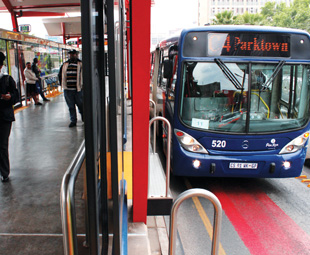Butting heads

With the continuing battle for funding and the butting of heads between different approaches to the provision of bus services, we explore the current state of local bus services and ask what can be done to ease the situation.
The debate among South African transport professionals and officials concerning the merits of bus rapid transit (BRT) systems continues to rage on. While existing bus services struggle from a lack of funding and government subsidies, local authorities around the country are investing millions of rand in BRT systems.
Adding to the tumultuous situation have been numerous news reports over the past months detailing low passenger numbers and woeful financial situations across both BRT and regional bus services.
On August 11, Pretoria News ran an article by independent transport analyst Paul Browning, who wrote about evidence of the potential financial burden of Pretoria’s A Re Yeng BRT system being borne by ratepayers. “Residents of Tshwane might be wary of a situation where perhaps ten percent of rates income must be devoted to the public transport system,” he said.
On September 6, the Sunday Independent reported that “the Forum of Limpopo Entrepreneurs had asked the Hawks and the public protector to look into alleged irregularities in the awarding of about
R81 million in contracts to BRT consultants in Polokwane”.
Then, on October 2, Business Day reported that “none of Johannesburg’s transport corridors has enough passenger demand to justify the Rea Vaya Bus Rapid Transit (BRT) system”.
Executive director of transportation for the city, Lisa Seftel, was quoted as saying demand was below international benchmarks for such bus systems – most of Johannesburg’s corridors having about 10 000 commuters, who could use Rea Vaya, compared to a minimum of 14 000 passengers in some South American countries.
Finally, on October 13, The Star reported that Johannesburg’s Metrobus “has lost nine percent of its users over the past year, with a loss of 1,3-million passengers. The city’s public transport entity recorded a net loss of R3,8 million in the fourth quarter – increasing its deficit by R5,7 million year-on-year to R90,8 million – as shown in its most recent quarterly report”.
The picture being painted is depressing, and it is clear that solutions need to be found to the funding woes, as well as to solve the overall bad relationships between the various BRT systems and their fellow bus services.
Speaking at the Southern African Bus Operators’ Association (SABOA) conference earlier this year, Philip van Ryneveld, from Hunter Van Ryneveld, suggested that the mindset must shift from conventional bus, versus BRT, to understanding the strengths and weaknesses of each.
He added that BRT could have positive spin-offs for the conventional bus industry, including direct business opportunities and increased resources and understanding.
“Institutional change is difficult, but a rationalisation of public authority is required in the transport sector,” he noted, stating that there needs to be integration of modes, land use and transport; along with a clear focus of accountability.
However, the question of funding lingers; especially regarding Integrated Rapid Public Transport Networks (IRPTNs), which require special infrastructure, vehicles and operations.
Three members of public sector consultancy Pegasys Strategy and Development – director Constantin von der Heyden and associate directors Peter Koch and Stephen de Stadler – have produced papers on these topics.
In his paper titled: Opportunities for public private partnerships in IRPTN infrastructure, De Stadler says: “The future budgeted capital funding required to roll out the proposed public transport investments are in excess of the level of grant funding likely to be available from the national fiscus.” He notes that third-party funding options need to be actively investigated and developed.
“By a careful analysis of all infrastructure elements, followed by a financial structuring exercise, it may be possible to reduce the current sole reliance on grant funding for infrastructure development,” he notes. One such option is that of public-private partnerships (PPPs).
De Stadler says, however, that the limited number of successful PPPs at municipal level suggests that they are not usually investigated to the fullest extent.
Among his recommendations to alleviate administrative issues and provide a source of additional funding to IRPTNs, De Stadler suggests identifying, at national level, those elements of the IRPTN that could be financed using the PPP methodology and the development by the PPP unit of national treasury of a uniform PPP approach.
He also suggests investigation, at national level, of potential donors or developmental financial institutions that may wish to partner with national and local government in this initiative.
In his paper entitled: IRPTN vehicle financing options and considerations, Koch states that acquisition of a bus fleet presents the second-largest component of capital expenditure by the implementing municipalities.
“A number of the first bus purchases were funded by grant funding, allocated and distributed in terms of the Division of Revenue Act (DORA). However, the grant framework (and the NDOT) has discouraged the use of grant funding for an up-front purchase, and has, instead, committed to repaying the capital, finance and transaction costs over time,” he notes.
Koch continues that neither model, in its pure form, has achieved the objectives of procuring financing at the lowest possible cost, or allows for the least complexity of implementation and management, yet also allows for the requisite level of municipal control and empowerment of the affected operators.
He suggests the Municipal Entity (ME) model, which, he says, seeks to combine the benefits of a corporate finance transaction to the municipality, while emphasising the empowerment and alignment benefits of a project finance transaction for the affected operators.
Koch explains: “An ME is a separate for-profit company incorporated in terms of Section 8 (2) of the Companies Act and as defined in the Municipal Systems Act. The municipality is required to hold a controlling interest in the company.
“The affected operators may be incorporated as minority shareholders. The ME enters into the agreement to purchase the buses and then leases the buses to the municipality, which, in turn, leases them to the operating company.”
There are numerous benefits to the ME model. “With the buses in the control of the City, the municipality is not beholden to an individual operator, or a third-party owner. The municipality can ensure that vehicles are properly cared for and maintained, reducing the long-term costs to the City.
“The ME further provides for the incorporation of the additional stakeholders, which ensures that the parties have an incentive to protect and manage the assets and work towards successful implementation and operation. This aids empowerment objectives, and allows the municipality to retain ownership of the residual value of the buses, once the initial contract has been concluded.”
That addresses the infrastructure and vehicles, but what about the operations? Von der Heyden, in his paper entitled: Financing IRPTN operations: considerations for cities implementing IRPTNs in South Africa, says that initial expectations were that fare income from passengers would cover at least the direct operating costs.
He notes, however: “There can be no single income source (in addition to fare revenue) as the silver-bullet solution.” Worryingly, he adds that even after pursuing all of the recommended funding options, it is likely that a fairly significant operational shortfall will remain.
To date, the main sources of funding have been fare revenue (around 20 percent of total operating costs), national grant funding (30 percent), municipal contributions and other sources. Roughly 45 percent of total operating costs are left to be funded by other sources.
These, he says, could be from municipal charges (inclusion in the rates bill), equitable shares, provincial cooperation, local government grants, the fuel levy, advertising and commercial revenue, carbon credits, land value capture, congestion charges, and parking levies.
Von der Heyden summarises: “Implementation of IRPTNs is proving to be a significant financial risk for city treasuries to undertake alone and, even with the additional sources of income, it will be difficult for cities to cover the operational shortfalls.
“Ultimately, this means that South Africa needs to either find more funding – most likely at a national level, possibly reprioritising away from other sectors – or IRPTN costs must decrease.”
It would seem that an end to public transport head butting is a long way off.
Vaughan Mostert developed a love for public transport early in life, which led to a lifelong academic interest in the subject. He recently retired as a senior lecturer from the Department of Transport and Supply Chain Management at the University of Johannesburg. Through Hopping Off, Mostert leaves readers with some parting food for thought as he continues his push for change in the local public transport industry.
Published by
Focus on Transport
focusmagsa




